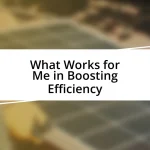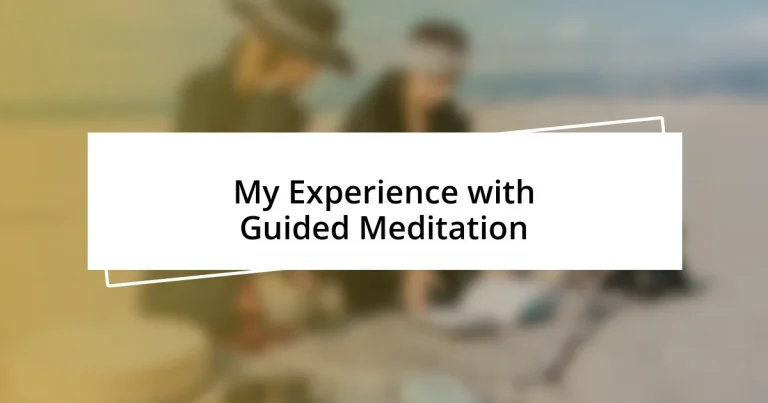Key takeaways:
- Guided meditation offers structured support, making it accessible and beneficial, especially for beginners seeking calm amidst daily chaos.
- Choosing the right session and creating a conducive meditation space enhances the experience, emphasizing personal connection and comfort.
- Overcoming common challenges, such as mind-wandering and emotional barriers, can deepen one’s practice and foster self-awareness and healing.
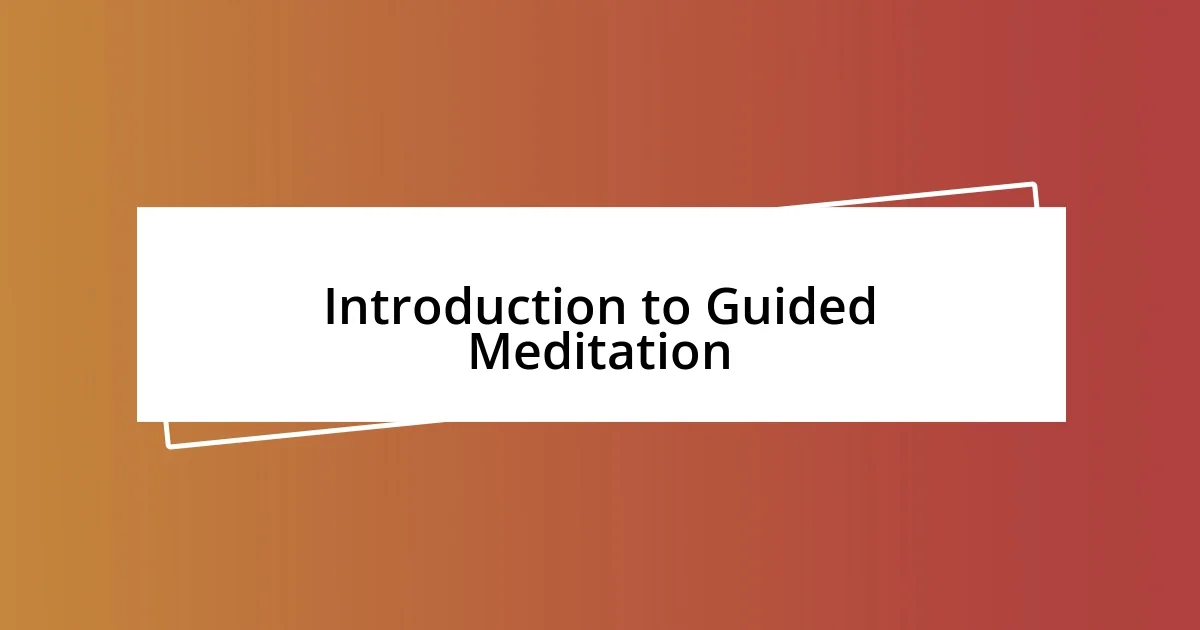
Introduction to Guided Meditation
Guided meditation is a practice that invites you to explore the depths of relaxation and self-discovery with the help of someone’s voice or a recording. I vividly remember my first session—it felt like being gently led through a forest, where every sound and every breath opened a new door to my inner thoughts. Have you ever thought about how much our minds crave a little direction amid the chaos of daily life?
The beauty of guided meditation lies in its accessibility. As a beginner, I often felt lost trying to meditate on my own, but when I found a guided session that resonated with me, it transformed the experience entirely. It was like having a trusted friend whispering to me, helping me release tension and embrace stillness. Isn’t it comforting to know that you don’t have to navigate this journey alone?
In essence, guided meditation serves as a bridge to tranquility, combining imagery, breath, and focus to cultivate mindfulness. I’ve experienced profound shifts in my mood and mental clarity through this practice, making it a vital part of my wellness routine. What if this simple act could help you find your calm amidst the storm?
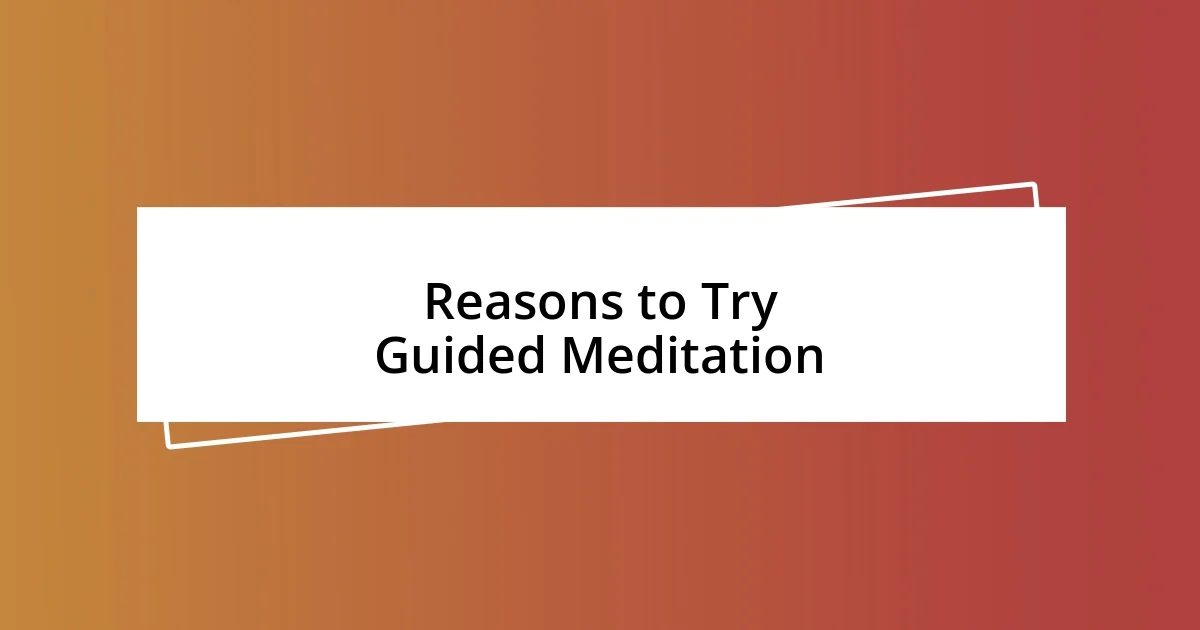
Reasons to Try Guided Meditation
Guided meditation offers a structured approach that can be especially beneficial for those new to the practice. I remember feeling overwhelmed by the silence during my initial attempts at meditation—my thoughts would race and I’d end up more distracted than peaceful. However, when I tried a guided session, it felt like someone was gently pulling me back to a state of calm whenever my mind wandered. Isn’t it remarkable how a bit of guidance can turn chaos into clarity?
Another compelling reason to explore guided meditation lies in the variety it offers. There’s an expansive range of themes—stress relief, self-love, and even sleep enhancement—that cater to different needs and moods. I’ve often found specific sessions that seem almost tailor-made for what I’m going through at that moment. It’s like having a personal toolkit for whatever emotional or mental state I find myself in, helping me navigate life’s ups and downs more gracefully.
Lastly, the sense of community that arises from engaging with guided meditation is a lovely bonus. I remember discovering online groups where people shared their experiences and favorite sessions, creating a network of support and encouragement. This connection can enhance the experience, reminding you that you’re not alone on your journey toward mindfulness. Have you ever experienced that sense of belonging, even in a quiet personal practice?
| Benefits | Description |
|---|---|
| Structured Guidance | Helps beginners navigate meditation with ease. |
| Variety of Themes | Offers targeted sessions for different needs and emotions. |
| Sense of Community | Encourages connection and shared experiences among practitioners. |
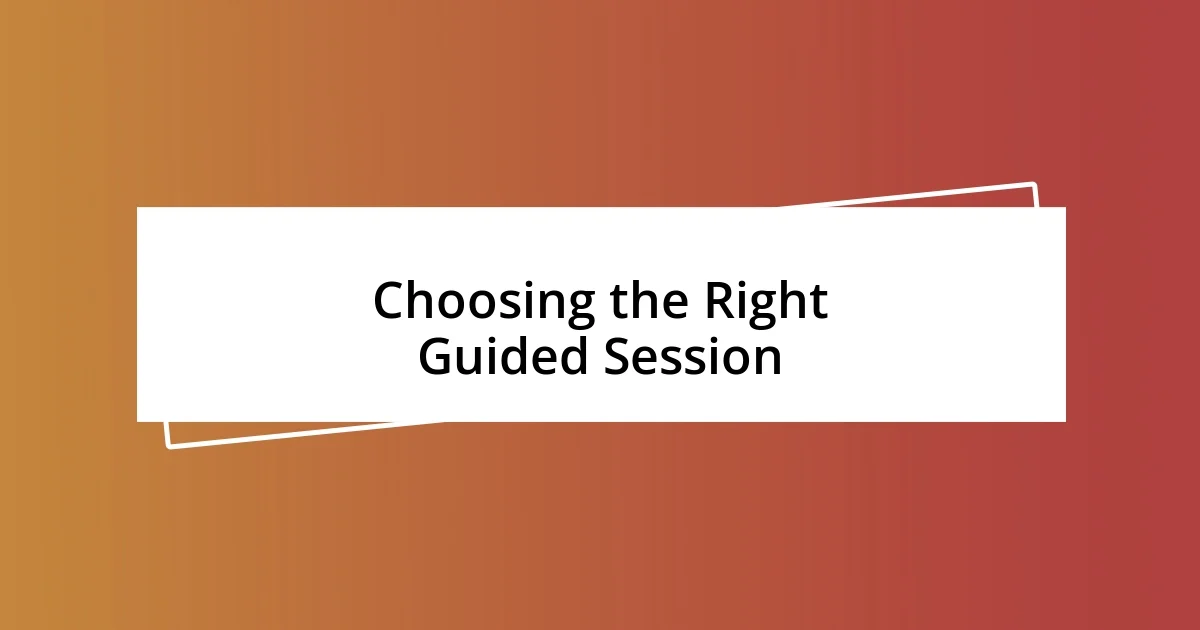
Choosing the Right Guided Session
Choosing the right guided meditation session can be a game-changer in your practice. I fondly recall one afternoon when I desperately needed to unwind. I sifted through various sessions until I stumbled upon a soothing voice paired with gentle piano music. It felt like wrapping myself in a warm blanket. That connection can make a world of difference—like finding a cozy nook just for you.
When selecting a session, consider what resonates with your current state of mind or specific needs. Here are some tips to guide you:
- Identify Your Goals: Decide if you’re seeking stress relief, emotional healing, or clarity.
- Explore Different Styles: Experiment with different meditation lengths and formats—guided imagery, body scans, or affirmations.
- Pay Attention to the Voice: The tone and energy of the guide can significantly impact your experience; choose someone whose voice feels comforting to you.
- Check for Reviews: Look for feedback from others to see if a session is worth your time.
- Trust Your Intuition: Sometimes, a particular session simply feels right. Trust that instinct!
Following these tips can lead you to a meditation experience that feels both personal and enriching. It’s all about finding what resonates with you at that moment.
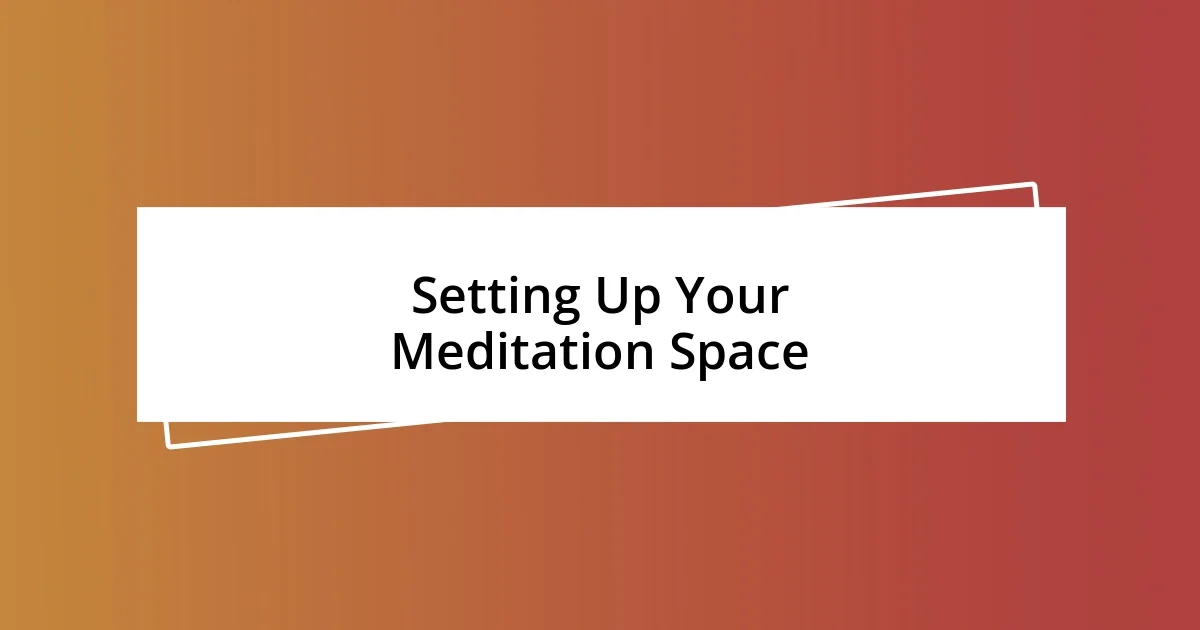
Setting Up Your Meditation Space
Creating the right meditation space is essential for fostering a peaceful atmosphere. I’ve experimented with various setups, and I find that even small details can significantly impact my experience. One time, I simply moved my favorite chair to a sunlit corner of the room, and it changed everything. Isn’t it curious how light can affect our mood?
I recommend surrounding yourself with items that evoke calmness. For instance, a soft blanket, essential oils, or calming artwork can transform your space into a sanctuary. I remember hanging up serene images of nature, and each time I looked at them, my thoughts shifted toward tranquility. It’s amazing how visuals can ground us, don’t you think?
Lastly, consider decluttering your meditation area. When I first began, I often overlooked the chaos around me; however, once I tidied up, my mind felt more organized, too. I realized that a clear space promotes a clear mind. Have you ever noticed how much easier it is to focus in an uncluttered environment? Taking the time to set up your space thoughtfully can lead to a more enriching meditation session.
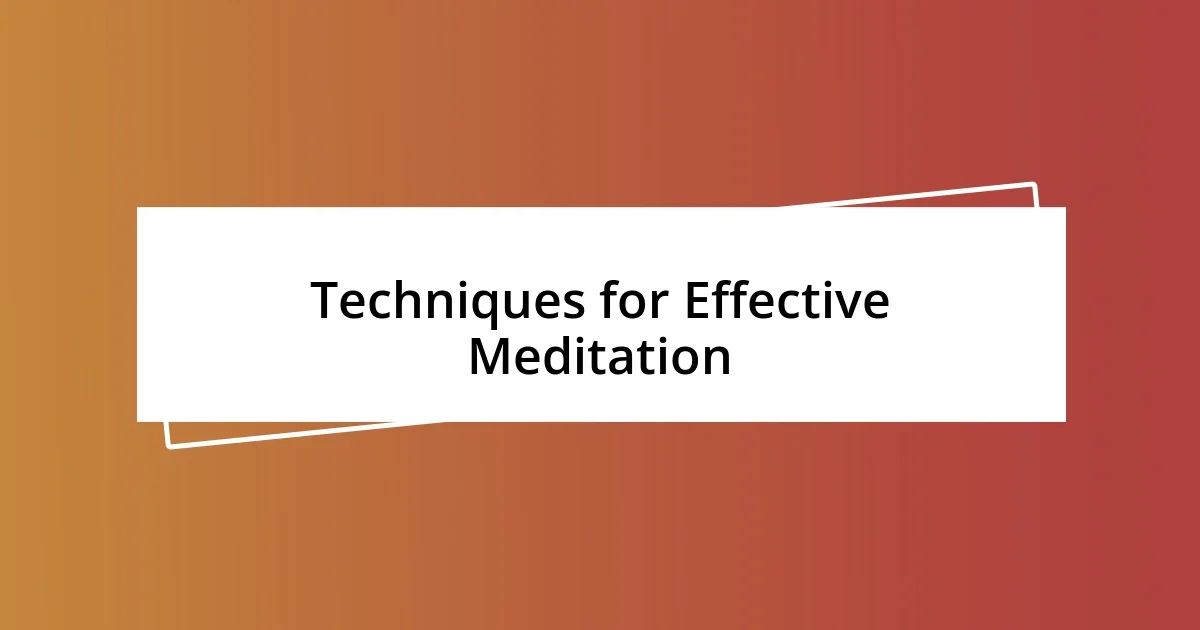
Techniques for Effective Meditation
Focusing on your breath is one of my favorite techniques for effective meditation. I remember one particularly stressful day when I struggled to silence my thoughts. So, I simply turned my attention to my breathing. Inhale deeply, and then exhale fully. This practice brought me back to the present moment, washing away my anxieties. Isn’t it fascinating how something as simple as breath can anchor us?
Another technique I find valuable is visualization. Visualizing a peaceful scene can invoke a profound sense of calm. I often picture myself sitting by a tranquil lake, surrounded by tall trees swaying gently in the breeze. Each time I immerse myself in this mental image, I can feel my worries softening. Have you ever tried visualizing a safe space? It opens up a realm of tranquility that’s always just a thought away.
Incorporating loving-kindness meditation is also transformative. This method allows me to cultivate compassion for myself and others. Once, after a session of focusing on sending love to those around me, I felt an overwhelming wave of warmth and connection. It’s incredible how shifting our focus outward can enhance our internal peace. Wouldn’t it be wonderful if we all took a moment to wish well for others? By practicing these techniques, we not only enhance our meditation but enrich our overall well-being.
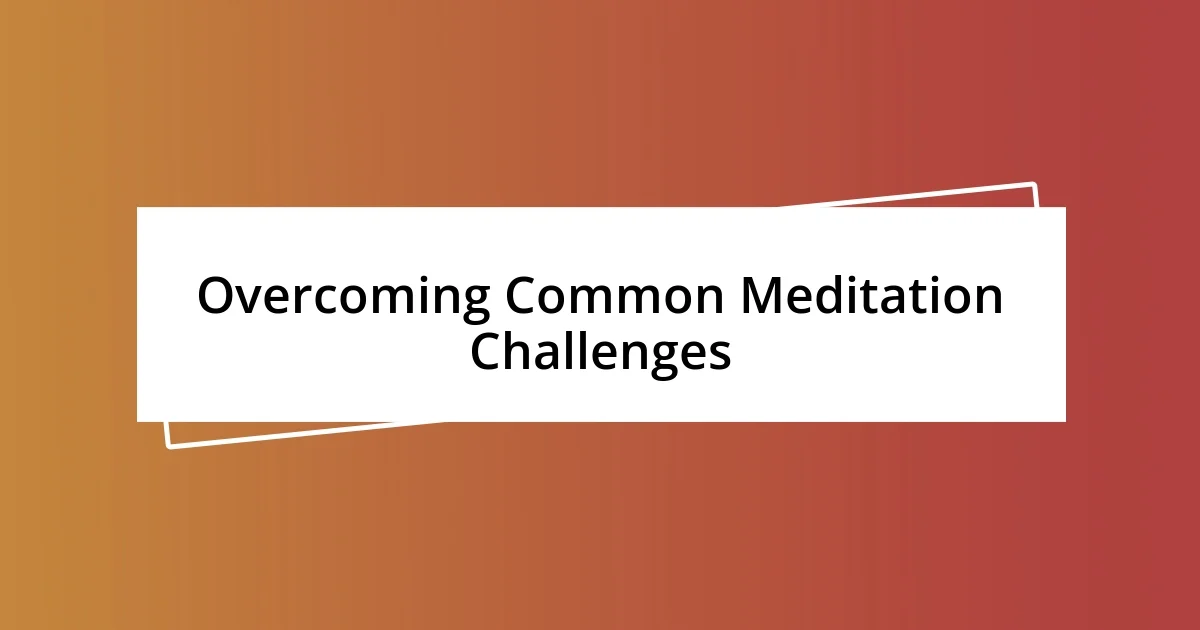
Overcoming Common Meditation Challenges
Meditation can be a challenge, especially when the mind seems to race. I recall the early days of my practice, where every session felt like a wrestling match with my thoughts. To tackle this, I learned to embrace distractions rather than fight them. When I noticed my mind wandering, I would gently acknowledge it and guide my focus back to my breath. Isn’t it amazing how allowing thoughts to drift in and out can create a sense of freedom rather than frustration?
Another common hurdle is finding the time for meditation. Life gets busy, right? I remember feeling guilty for not dedicating a full half-hour to my sessions. Eventually, I realized that even five minutes can be impactful. I began weaving short meditative moments into my day—like during my morning coffee or before bed. Have you ever considered how small moments can yield significant benefits? Embracing this flexibility empowered me to maintain my practice without the pressure of a rigid schedule.
Sometimes, emotional barriers pop up during meditation. I vividly recall sitting in silence when an unexpected wave of sadness washed over me. Instead of resisting, I chose to sit with that feeling, allowing it to emerge and pass naturally. This experience taught me that it’s okay to feel; emotions are part of the journey, and acknowledging them can lead to deeper self-awareness. Isn’t it interesting how meditation can serve as a mirror, reflecting our innermost experiences? By accepting our emotions, we create a more profound space for healing during our practice.
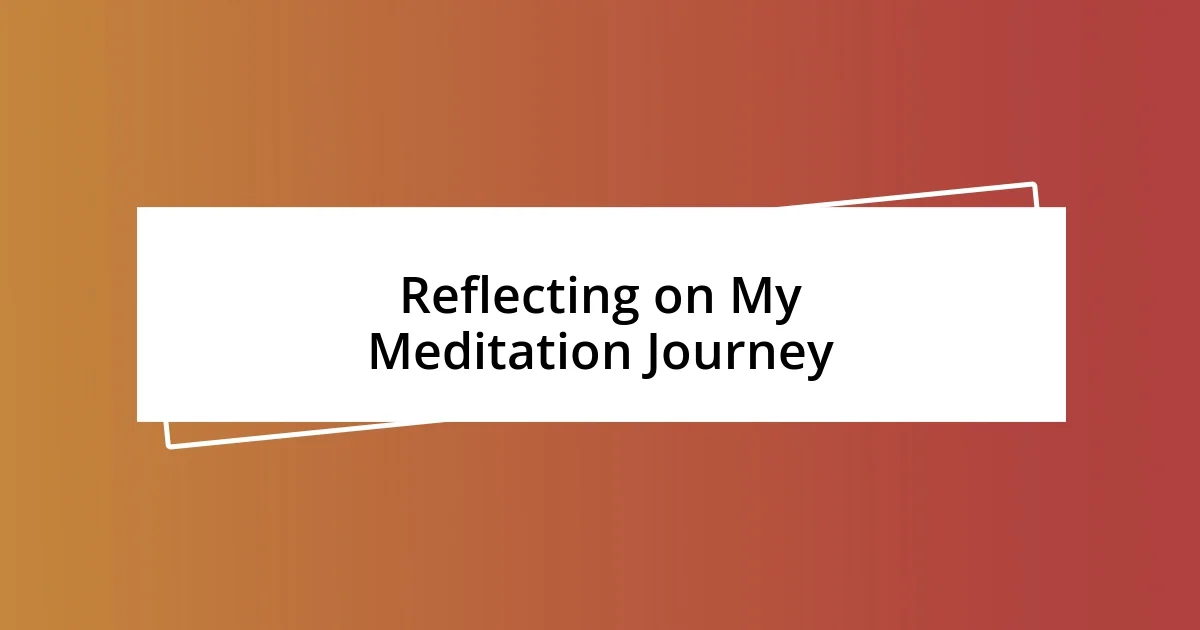
Reflecting on My Meditation Journey
Reflecting on my meditation journey reveals layers of growth I never expected. I still vividly remember the first time I completed a guided session. My heart raced as I followed the narrator’s voice, feeling a mix of anticipation and skepticism. But as I sank into the guidance, I felt an unfamiliar calm wash over me. It’s remarkable how something as simple as listening can lead to profound inner peace.
Over time, I’ve learned that meditation is not just about silence; it’s about connection. There were days when the chaos of life seeped into my meditation, leaving me frustrated and disconnected. However, on one particularly hectic day, I opened my eyes mid-session and noted how those distractions were my thoughts and feelings trying to be heard. This realization shifted my perspective—embracing those moments instead of resisting them allowed me to deepen my practice. Isn’t it fascinating how our greatest hurdles can sometimes act as gateways to greater understanding?
As I reflect, I also recognize the importance of community in my journey. Joining a meditation group introduced me to different styles and perspectives, enriching my experience. I still recall the warmth in the room during our silent sits, where shared energy creates a supportive atmosphere. There’s something beautifully comforting about knowing others are on a similar path, don’t you think? Those moments not only validated my struggles but also inspired me to explore my practice further, turning meditation into a shared form of healing.


